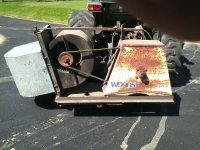ns_in_tex
Platinum Member
- Joined
- Mar 24, 2002
- Messages
- 914
- Location
- East Texas
- Tractor
- Kubota L4610 HSTC, International 2400, Hesston 1280,
We would like to improve on our driveway blower.
It blows good, but you know, we want to Tim Taylor it.
We have a side discharge as well as a front discharge. Each has it's good points, but takes time to change.
Also when we run full speed, it makes the fins come loose on our blower wheel.
So, I am thinking, we need a heavy duty blower, maybe like sawmill collection blower, then put a hydraulic controlled discharge which we could change direction of discharge on the go. Of course, might go another route & make a vacuum system out of it.
Where might we find a blower that would load up to, maybe 20 HP, and we could run at half throttle, but move Tim Taylor type air.
Any suggestions appreciated.
It blows good, but you know, we want to Tim Taylor it.
We have a side discharge as well as a front discharge. Each has it's good points, but takes time to change.
Also when we run full speed, it makes the fins come loose on our blower wheel.
So, I am thinking, we need a heavy duty blower, maybe like sawmill collection blower, then put a hydraulic controlled discharge which we could change direction of discharge on the go. Of course, might go another route & make a vacuum system out of it.
Where might we find a blower that would load up to, maybe 20 HP, and we could run at half throttle, but move Tim Taylor type air.
Any suggestions appreciated.



